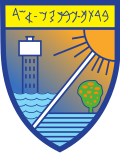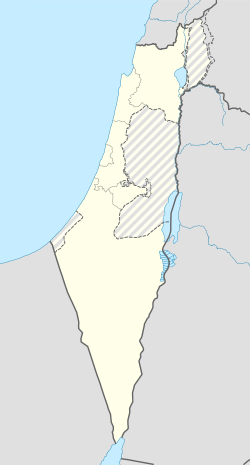Nahariya
Nahariyya
| |
|---|---|
City (from 1961) | |
| Hebrew transcription(s) | |
| • ISO 259 | Nahariyya |
| Coordinates: 33°00′21″N 35°05′56″E / 33.00583°N 35.09889°E | |
| Country | |
| District | Northern |
| Sub-district | Acre |
| Founded | 1400 BCE (Khirbet Kabarsa) 1935 (Modern city) |
| Government | |
| • Mayor | Ronen Marelly |
| Area | |
• Total | 10,233 dunams (10.233 km2 or 3.951 sq mi) |
| Population (2023)[1] | |
• Total | 63,947 |
| • Density | 6,200/km2 (16,000/sq mi) |
| Ethnicity | |
| • Jews | 81.2% |
| • Arabs | 2.4% |
| • Others | 16.4% |
Nahariya (Hebrew: נַהֲרִיָּה) is the northernmost coastal city in Israel. As of 2022, the city had a population of 63,947.[1]
The city was founded in 1935 by Jewish refugees fleeing Nazi Germany.[2][3]
Etymology
Nahariya takes its name from the stream of Ga'aton (river is נהר nahar in Hebrew), which bisects it.[4]
History
Bronze Age
The ruins of a 3,400-year-old Bronze Age citadel were found in the coastal city of Nahariya near the beach on Balfour Street,[5] at a site known to archaeologists as Khirbet Kabarsa.[6] The citadel was an administrative center serving the mariners who sailed along the Mediterranean coast. There is evidence of commercial and cultural relations with Cyprus and the rest of the Mediterranean region. The fortress was destroyed four times by conflagration and rebuilt each time.[citation needed]
Byzantine period

A church from the
British Mandate of Palestine



In 1934, work began to found Nahariya as an agricultural village by a company limited by shares and headed by the agronomist Dr.
After an accumulation of economic and climatic problems the residents soon realized that agriculture was impractical and chose to focus on tourism and the food industry. Nahariya was turned into a European-style resort town, taking advantage of the natural surroundings and beaches, and new inns were opened. Two prominent food manufacturers also set up shop: the Strauss company was founded as a commercial dairy by German immigrants in Nahariya, and the Soglowek family, which settled in Nahariya in 1937, opened a prominent butcher shop, and developed the "Nahariya sausage". During the British Mandate of Palestine, many British officers coming from Khartoum stopped in Nahariya.[citation needed]
State of Israel

In 1948 when Israel was founded Nahariya had a population of 1,700. It became a
Israeli–Arab conflict
Due to its geographic location, 9.6 km (6.0 mi) down the coast from Israel's border with Lebanon, Nahariya had been a frequent target of cross-border terrorist attacks by Palestinian militants, mortar attacks and Katyusha rocket fire during the 1970s. The most notable of those were the 1974 attack and the 1979 Nahariya attack.[citation needed]
During the 2006 Lebanon War in July–August 2006, Nahariya sustained a barrage of several hundreds of Katyusha rockets launched by Hezbollah from southern Lebanon. As a result, the city suffered multiple civilian casualties and 5 fatalities. Significant damage was also inflicted on property and physical infrastructure. Nahariya's economy suffered a major blow, as two-thirds of the city's population had to evacuate, with the rest spending weeks in bomb shelters.[8]
During the
Economy


Nahariya is home to some of Israel's leading entrepreneurs: the Strauss, Soglowek and Wertheimer families. Successful private sector industrial enterprises founded in Nahariya are the Strauss dairy company, Soglowek meat processing company, and Iscar—the high-precision metalworks and tool-making giant, which was purchased by Berkshire Hathaway for US$5 billion.[10]
According to the CBS, as of 2000 there were 17,916 salaried workers in the city and 1,283 were self-employed. The mean monthly wage in 2000 for a salaried worker in the city was
Tourism
Sderot Ga'aton, the city's main boulevard, runs east–west from the Coastal Highway junction to the sea, and is divided down the middle by the Ga'aton River. Shaded by the thick greenery of towering eucalyptus trees and lined with numerous shops, boutiques, open-air cafes, restaurants and ice cream parlors, Sderot Ga'aton is Nahariya's main tourist attraction and its central business and entertainment district.[11] The beach area is an attraction in its own right, with a public park, a waterfront promenade, two public beaches, several hotels, a small marina and a lively nightlife in the multitude of beachfront cafes, bars, restaurants and nightclubs.[citation needed]
Transportation

Demographics
According to
Following Israel's withdrawal from Lebanon in 2000 many ex South Lebanon Army soldiers and officers who fled from Lebanon settled in Nahariya with their families.[12]
Schools and public institutions

According to the CBS, Nahariya has 22 schools with 7,541 students, which are divided into 15 elementary schools with 4,074 students, and 7 middle and high schools with 3,467 students. In 2001, high school (12th grade) matriculation rate in the city was 56.5%.
Notable people

- Gai Assulin (born 1991), football player
- Dalia Dorner (born 1934), former Justice of the Supreme Court of Israel
- Yael Shelbia (born 2001), social media model
- Selig Soskin (1873–1959), agronomist and early member of the Zionist movement
- Ofra Strauss (born 1960), business magnate and industrialist
- Israel Basketball Premier League
- Viktor Tsyhankov (born 1997), Ukrainian professional footballer
- Stef Wertheimer (born 1926), German-born Israeli entrepreneur, industrialist, and politician
Twin towns – sister cities
 Bielefeld, Germany
Bielefeld, Germany Issy-les-Moulineaux, France
Issy-les-Moulineaux, France Kecskemét, Hungary
Kecskemét, Hungary Lefkada, Greece
Lefkada, Greece Liberec, Czech Republic
Liberec, Czech Republic Miami Beach, United States
Miami Beach, United States Tempelhof-Schöneberg (Berlin), Germany
Tempelhof-Schöneberg (Berlin), Germany
References
- ^ a b c "Regional Statistics". Israel Central Bureau of Statistics. Retrieved 21 March 2024.
- ^ a b Klaus Kreppel: Nahariya’s Early Years 1934–1949 Archived 2013-01-15 at the Wayback Machine
- ISBN 978-1-138-06898-8.
- ^ Efraim Orni and Shaked Gilboa (2007). "Nahariyyah". In Fred Skolnik (ed.). Encyclopedia Judaica. Vol. 14 (2 ed.). Keter Publishing House. p. 737.
- ^ "3,400-Year-Old Citadel Found in Basement : Discovery News". Archived from the original on 2016-01-09. Retrieved 2016-01-11.
- JSTOR 23398920.).
- ^ .
- ^ a b Watch (Organization), Human Rights; Goldstein, Eric (November 30, 2007). "Civilians Under Assault: Hezbollah's Rocket Attacks on Israel in the 2006 War". Human Rights Watch – via Google Books.
- ^ "Alerts in Nahariya, Israel's National Emergency Portal".
- ^ "Nahariya". Archived from the original on 2013-05-27. Retrieved 2011-10-03.
- ^ "Nahariya". Archived from the original on 2007-11-02. Retrieved 2007-12-17.
- S2CID 211647029.
- ^ "דוחמבקרהעירייה 2012" (PDF). nahariya.muni.il (in Hebrew). Nahariya. April 2013. p. 25-26. Retrieved 2020-02-24.
External links
- Official website Archived 2018-05-13 at the Wayback Machine (in Hebrew)









